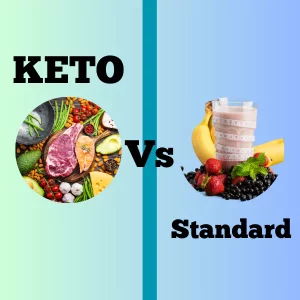
I’m here to shed light on a common phenomenon that many people experience when starting a ketogenic diet – the dreaded “Keto Flu.” This peculiar set of symptoms can catch newcomers off-guard and leave them wondering what’s going on. In this article, I’ll delve into the details of what the Keto Flu actually is and why it happens, giving you a better understanding of this temporary roadblock on your path to a healthier lifestyle. So, let’s dive in and uncover the secrets of the Keto Flu!

Overview
Definition of the Keto Flu
The Keto Flu refers to a collection of symptoms that can occur during the initial stages of transitioning into a ketogenic diet. As the body adjusts to a low-carbohydrate intake and begins to use fat as its primary source of fuel, some individuals may experience temporary discomfort due to the metabolic changes taking place.
Causes of the Keto Flu
The primary cause of the Keto Flu is the significant reduction of carbohydrates in the diet. When carbohydrates are restricted, the body starts to deplete its glycogen stores, which triggers a series of metabolic adaptations. The sudden change in fuel source can lead to various symptoms associated with the Keto Flu.
Duration of the Keto Flu
The duration of the Keto Flu can vary from person to person. Some individuals may experience symptoms for only a few days, while others may endure them for up to a couple of weeks. The severity and duration of symptoms can also be influenced by factors such as overall health, level of carbohydrate restriction, and how effectively the body adapts to the new metabolic state.
Symptoms
Fatigue
One of the most common symptoms of the Keto Flu is fatigue. As the body adapts to using fat as its primary energy source, there may be a temporary dip in energy levels. This fatigue can feel similar to the sensation experienced during the early stages of starting a new exercise routine.
Headache
Headaches are another frequent symptom associated with the Keto Flu. These headaches can range from mild to severe and may be accompanied by feelings of general discomfort. The exact cause of these headaches is not fully understood, but they are believed to be related to electrolyte imbalances and changes in brain metabolism.
Brain Fog
Many individuals transitioning into ketosis report experiencing mental fogginess or difficulty concentrating. This symptom, often referred to as “brain fog,” can make it challenging to focus on tasks and may affect overall cognitive function. The cognitive challenges associated with the Keto Flu tend to resolve as the body becomes more adapted to utilizing fat as its primary fuel source.
Nausea
Nausea is a less common symptom but can still affect some individuals during the Keto Flu period. The feeling of queasiness is typically temporary and resolves as the body adjusts to its new metabolic state. Staying hydrated and consuming easily digestible foods can help alleviate nausea during this period.
Dizziness
Dizziness is another symptom that some individuals experience while transitioning into ketosis. This lightheaded or unsteady feeling can occur due to a drop in blood sugar levels or a decrease in fluid and electrolyte balance. It is essential to monitor dizziness closely and seek appropriate medical advice if it persists or becomes severe.
Irritability
The Keto Flu can affect mood, leading to increased irritability or mood swings. The hormonal changes associated with the adaptation process, as well as potential fluctuations in blood sugar levels, can contribute to feelings of irritability. Taking measures to maintain stable blood sugar levels and engaging in stress-reduction techniques can help alleviate this symptom.
Muscle Cramps
Muscle cramps are a common complaint during the Keto Flu. These cramps can be experienced in various muscles throughout the body and are often attributed to electrolyte imbalances and dehydration. Adequate hydration and proper replenishment of electrolytes can help alleviate muscle cramps during this period.

Transitioning into Ketosis
Metabolic Changes
Transitioning into ketosis involves significant metabolic changes within the body. When carbohydrates are restricted, the liver begins to produce ketones, which are small fuel molecules derived from the breakdown of fat. These ketones then become the primary source of energy for the body. This transition requires the body to shift from primarily utilizing glucose as its energy source to relying on fat and ketones.
Adapting to Fat as the Primary Fuel Source
The body’s ability to adapt to using fat as its primary fuel source is crucial during the transition into ketosis. Initially, as the body depletes its glycogen stores, there may be a temporary drop in energy levels. However, with consistent adherence to the ketogenic diet, the body becomes more efficient at utilizing fat for fuel, leading to sustained energy levels and improved metabolic flexibility.
Electrolyte Imbalance
Importance of Electrolytes
Electrolytes are minerals present in the body that play a vital role in maintaining proper fluid balance and facilitating nerve and muscle function. During the transition into ketosis, electrolyte imbalances can occur due to increased fluid loss and changes in metabolic processes. Replenishing electrolytes, particularly sodium, potassium, and magnesium, is crucial to preventing and alleviating symptoms associated with the Keto Flu.
Sodium Deficiency
When transitioning into ketosis, there is a significant reduction in dietary sodium intake, mainly due to the avoidance of processed and salted foods. This reduction can lead to sodium deficiency, resulting in symptoms such as fatigue, dizziness, and muscle cramps. Increasing sodium intake through the consumption of natural sources like sea salt or adding it to meals can help address this deficiency.
Potassium Deficiency
Potassium is vital for maintaining proper heart and muscle function. When carbohydrate intake is restricted, there is a decreased intake of potassium-rich foods such as fruits and certain vegetables. This reduction can lead to potassium deficiency, which can cause symptoms such as muscle weakness and cramps. Including potassium-rich foods like avocados, leafy greens, and nuts in the diet can help prevent potassium deficiency.
Magnesium Deficiency
Magnesium plays a crucial role in numerous bodily functions, including energy production, muscle function, and nerve transmission. Low-carbohydrate diets may contribute to magnesium deficiency due to reduced intake of magnesium-rich foods like whole grains and legumes. Magnesium deficiency can result in symptoms such as muscle cramps, fatigue, and irritability. Consuming magnesium-rich foods such as nuts, seeds, and leafy greens or considering magnesium supplementation can help mitigate this deficiency.

Fluid Loss and Dehydration
Increased Urination
One of the initial changes that occur when transitioning into ketosis is increased urine production. This increased urination is a result of the body’s depletion of glycogen stores and the excretion of water associated with carbohydrate metabolism. As a consequence, significant fluid loss occurs, potentially leading to dehydration if not properly addressed.
Water Retention
Despite the initial increase in urine production, the body may also retain water during the transition into ketosis. This water retention is a response to the decrease in insulin levels that occurs with carbohydrate restriction. While it may seem contradictory, water retention is a normal part of the adaptation process and tends to resolve as the body reaches a new metabolic equilibrium.
Tips to Stay Hydrated
Staying hydrated is essential during the transition and throughout a ketogenic diet. Increasing water intake can help counteract fluid loss and prevent dehydration. Adding a pinch of salt to water or consuming mineral-rich broths can help replenish sodium and other electrolytes. Additionally, incorporating foods with high water content, such as cucumbers and leafy greens, can contribute to hydration.
Carbohydrate Withdrawal
Carbohydrate Dependency
Carbohydrate withdrawal is a common experience during the transition into ketosis. The body becomes accustomed to utilizing glucose as its primary source of energy, leading to a reliance on carbohydrates for fuel. The reduction in carbohydrate intake can initially cause discomfort as the body adapts to using fat and ketones as its primary energy sources.
Insulin Resistance
Insulin resistance is a condition where the body becomes less responsive to the hormone insulin, leading to elevated blood sugar levels. Individuals with insulin resistance may experience more pronounced symptoms during the Keto Flu period due to the disruption in glycolytic metabolism. Adhering to a low-carbohydrate, ketogenic diet can help improve insulin sensitivity over time.
Blood Sugar Regulation
The Keto Flu can temporarily disrupt blood sugar regulation due to the reduction in carbohydrate intake. As the body adjusts to utilizing fat and ketones for fuel, blood sugar levels may fluctuate. These fluctuations can contribute to symptoms such as headaches, fatigue, and irritability. However, as the body becomes more accustomed to ketosis, blood sugar regulation typically stabilizes.
Nutrient Deficiencies
Lack of Variety in Keto Diet
One potential drawback of a ketogenic diet is the reduced variety of foods available compared to a more conventional diet. This limitation can increase the risk of nutrient deficiencies if not carefully managed. To ensure an adequate intake of essential nutrients, it is important to diversify food choices and incorporate a wide range of nutrient-dense foods.
Vitamins and Minerals
Vitamins and minerals play crucial roles in various bodily functions and are essential for overall health. However, certain nutrients may be less abundant in a ketogenic diet due to the limited food options. To prevent nutrient deficiencies, it is vital to prioritize foods rich in vitamins and minerals, such as leafy greens, nuts, seeds, and low-carbohydrate vegetables.
Importance of a Balanced Diet
Balancing macronutrient intake and focusing on nutrient-dense foods are key aspects of managing the Keto Flu and preventing nutrient deficiencies. A well-formulated ketogenic diet should prioritize adequate protein intake, healthy fats, and a variety of low-carbohydrate vegetables. Additionally, considering supplementation under the guidance of a healthcare professional can help address specific nutrient needs.
Mitigating Keto Flu Symptoms
Gradual Reduction of Carbohydrates
One effective strategy for mitigating the severity and duration of the Keto Flu is to gradually reduce carbohydrate intake rather than making drastic changes overnight. This gradual reduction allows the body to adapt more smoothly to ketosis and can help minimize the intensity of symptoms.
Proper Hydration
Ensuring proper hydration is crucial for managing the Keto Flu. Drinking adequate amounts of water and replenishing electrolytes can help alleviate symptoms such as fatigue, dizziness, and muscle cramps. Monitoring urine color can serve as a general indicator of hydration status, aiming for a pale yellow color as a sign of adequate hydration.
Supplementing Electrolytes
Supplementing electrolytes, particularly sodium, potassium, and magnesium, can be beneficial during the Keto Flu period. This supplementation can help prevent or alleviate symptoms like muscle cramps, fatigue, and dizziness. Choosing high-quality electrolyte supplements or incorporating natural sources like sea salt and mineral-rich foods can help maintain electrolyte balance.
Consuming Adequate Calories
Maintaining an adequate calorie intake is essential during the transition period to ensure the body receives sufficient energy and nutrients. Caloric intake should be tailored to individual needs and goals, taking into account factors such as activity level, body composition, and overall health. Aiming for a balance between fat, protein, and carbohydrates within the context of a ketogenic diet is important for overall well-being.
Getting Sufficient Sleep
Sufficient sleep is crucial for overall health and can aid in the management of Keto Flu symptoms. During the transition into ketosis, the body undergoes significant metabolic changes that may impact sleep quality. Prioritizing a regular sleep schedule, creating a comfortable sleep environment, and practicing relaxation techniques can help optimize sleep and aid in symptom management.
When to Seek Medical Advice
Persistent or Severe Symptoms
While the Keto Flu is generally temporary and self-limiting, persistent or severe symptoms may warrant medical advice. If symptoms such as extreme fatigue, severe headaches, or persistent vomiting occur, seeking professional medical guidance is recommended. A healthcare professional can evaluate the individual’s overall health status and provide appropriate guidance and support.
Underlying Health Conditions
Individuals with pre-existing health conditions should exercise caution when transitioning into a ketogenic diet. Certain medical conditions, such as diabetes or kidney disease, may require specific modifications or supervision during the transition. Consulting with a healthcare professional can help ensure a safe and tailored approach to the ketogenic diet.
Consulting a Healthcare Professional
If any concerns arise during the Keto Flu period or while transitioning into a ketogenic diet, consulting a healthcare professional is always a wise decision. Healthcare professionals can provide personalized advice based on an individual’s specific health needs and circumstances. They can help monitor progress, address any potential complications, and guide individuals towards an optimal ketogenic experience.
Conclusion
Understanding the Keto Flu and the symptoms associated with transitioning into ketosis is crucial for successfully navigating the initial stages of a ketogenic diet. By gradually reducing carbohydrate intake, maintaining proper hydration, supplementing electrolytes, consuming adequate calories, and getting sufficient sleep, individuals can effectively manage the symptoms of the Keto Flu.
While the discomfort may be temporary, seeking medical advice when necessary and maintaining a balanced approach to nutrition can help individuals enjoy the long-term benefits of ketosis.






